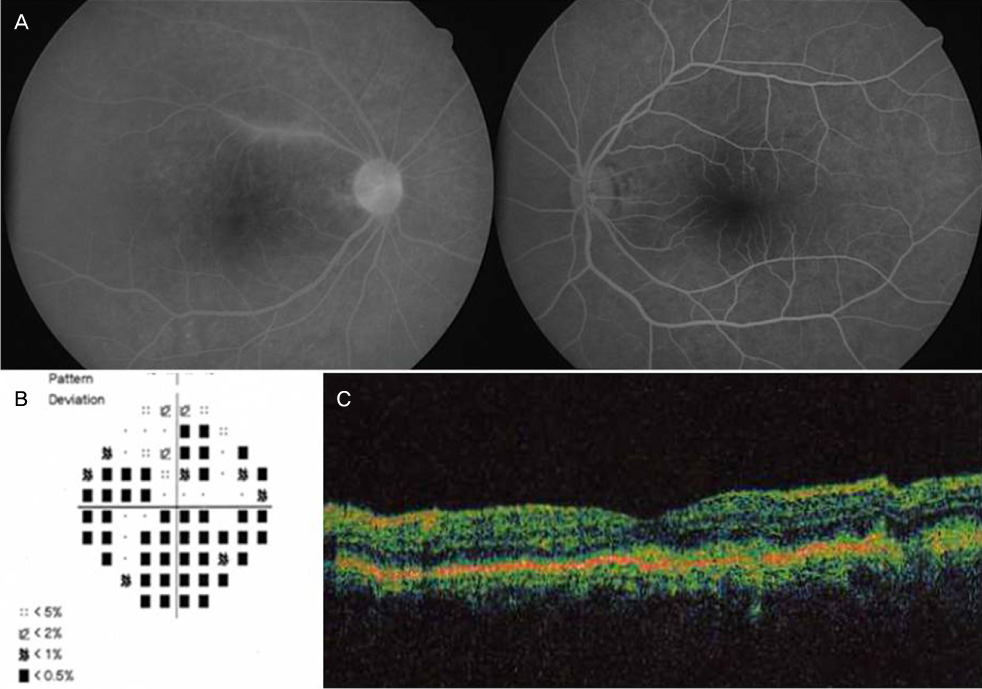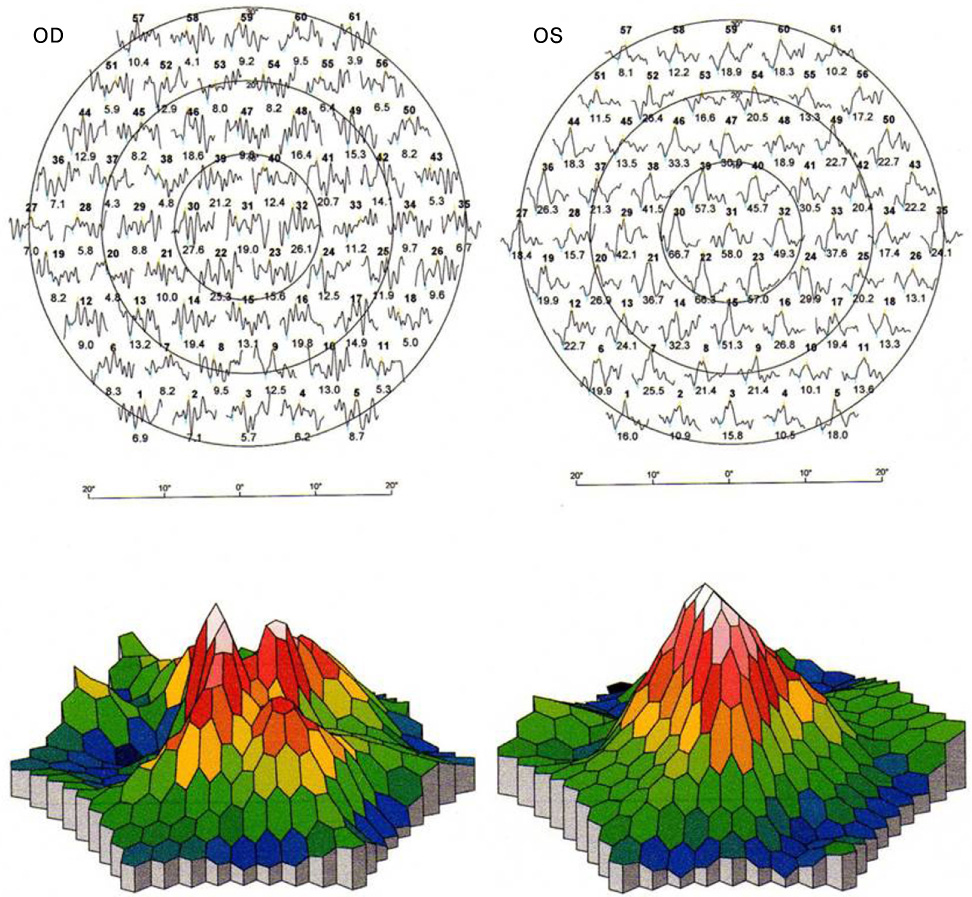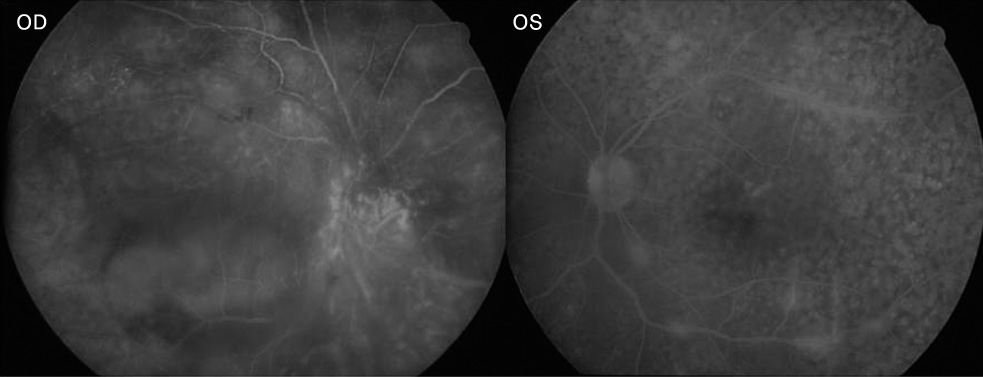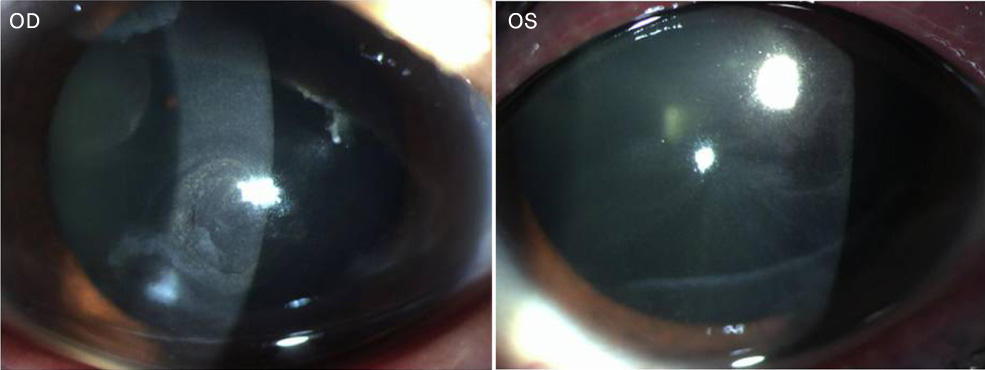Korean J Ophthalmol.
2009 Sep;23(3):210-214. 10.3341/kjo.2009.23.3.210.
A Case of Primary Intraocular Lymphoma Treated by Intravitreal Methotrexate
- Affiliations
-
- 1Department of Ophthalmology, Daegu Fatima Hospital, Daegu, Korea. vitreo-retina@hanmail.net
- 2Department of Ophthalmology, School of Medicine, Pusan National University, Busan, Korea.
- KMID: 1115756
- DOI: http://doi.org/10.3341/kjo.2009.23.3.210
Abstract
- A 40-year-old female visited our clinic for visual disturbance of the right eye, in which a few creamy-yellow retinal lesions and visual field constrictions were noted. She had been treated for primary CNS lymphoma and was in complete remission. After failure to follow-up for three months, she lost vision in the right eye, at which time active panuveitis was seen. Decreased vision and field constriction was observed in the left eye. Her left eye showed a granular pattern and dye leakage from the vessels and disc on fluorescein angiography and small RPE humps were seen in optical coherence tomography (OCT). Diffuse large malignant B-cells with strong immunoreactivities with CD20 immunostaining were seen in the epiretinal membrane biopsy specimen. Intravitreal injections of methotrexate (MTX) (800 microgram/0.1 ml in the right eye, 400 microgram/0.05 ml in the left eye) were performed twice weekly for one month, once weekly for the following month, once every two weeks for the next month, followed by nine monthly injections. Both eyes were free from malignant cells on vitreous biopsy six months later. There was no leakage seen by angiography, but the granular pattern persisted. Visual field constriction was slightly improved, and the small RPE humpsdetachments seen in OCT disappeared. EOG Arden ratio was decreased in both eyes, and b wave amplitude of scotopic ERG was decreased in the left eye. She was free from recurrence until six months later. No ocular complications except minimal opacity of the crystalline lenses were noted in both eyes.
Keyword
MeSH Terms
Figure
Reference
-
1. Chan CC, Buggage RR, Nussenblatt RB. Intraocular lymphoma. Curr Opin Ophthalmol. 2002. 13:411–418.2. Peterson K, Gordon KB, Heinemann MH, DeAngelis LM. The clinical spectrum of ocular lymphoma. Cancer. 1993. 72:843–849.3. Davis JL. Diagnosis of intraocular lymphoma. Ocul Immunol Inflamm. 2004. 12:7–16.4. Nussenblatt RB, Chan CC, Wilson WH, et al. International Central Nervous System and Ocular Lymphoma Workshop: recommendations for the future. Ocul Immunol Inflamm. 2006. 14:139–144.5. Hochberg FH, Miller DC. Primary central nervous system lymphoma. J Neurosurg. 1988. 68:835–853.6. Lee SH, Kim DJ, Kim IT. A Case of Primary Central Nervous System Lymphoma with Ocular Involvement. J Korean Ophthalmol Soc. 2005. 46:565–571.7. Nelson DF, Martz KL, Bonner H, et al. Non-Hodgkin's lymphoma of the brain: can high dose, large volume radiation therapy improve survival? Report on a prospective trial by the Radiation Therapy Oncology Group (RTOG): RTOG 8315. Int J Radiat Oncol Biol Phys. 1992. 23:9–17.8. Batchelor TT, Kolak G, Ciordia R, et al. High-dose methotrexate for intraocular lymphoma. Clin Cancer Res. 2003. 9:711–715.9. Berenbom A, Davila RM, Lin HS, Harbour JW. Treatment outcomes for primary intraocular lymphoma: implications for external beam radiotherapy. Eye. 2007. 21:1198–1201.10. Margolis L, Fraser R, Lichter A, Char DH. The role of radiation therapy in the management of ocular reticulum cell sarcoma. Cancer. 1980. 45:688–692.11. Sou R, Ohguro N, Maeda T, et al. Treatment of primary intraocular lymphoma with intravitreal methotrexate. Jpn J Ophthalmol. 2008. 52:167–174.12. Frenkel S, Hendler K, Siegal T, et al. Intravitreal methotrexate for treating vitreoretinal lymphoma: 10 years of experience. Br J Ophthalmol. 2008. 92:383–388.13. Behin A, Hoang-Xuan K, Carpentier AF, Delattre JY. Primary brain tumours in adults. Lancet. 2003. 361:323–331.14. Rothova A, Ooijman F, Kerkhoff F, et al. Uveitis masquerade syndromes. Ophthalmology. 2001. 108:386–399.15. Ursea R, Heinemann MH, Silverman RH, et al. Ophthalmic, ultrasonographic findings in primary central nervous system lymphoma with ocular involvement. Retina. 1997. 17:118–123.16. Corriveau C, Easterbrook M, Payne D. Lymphoma simulating uveitis (masquerade syndrome). Can J Ophthalmol. 1986. 21:144–149.17. Whitcup SM, de Smet MD, Rubin BI, et al. Intraocular lymphoma. Clinical and histopathologic diagnosis. Ophthalmology. 1993. 100:1399–1406.18. Wang JK, Yang CM, Lin CP, et al. An Asian patient with intraocular lymphoma treated by intravitreal methotrexate. Jpn J Ophthalmol. 2006. 50:474–478.19. Velez G, Yuan P, Sung C, et al. Pharmacokinetics and toxicity of intravitreal chemotherapy for primary intraocular lymphoma. Arch Ophthalmol. 2001. 119:1518–1524.
- Full Text Links
- Actions
-
Cited
- CITED
-
- Close
- Share
- Similar articles
-
- Primary Intraocular T-cell Lymphoma
- Therapeutic Effects of Intravitreal Methotrexate Injection for Intraocular Lymphoma Diagnosed Using Immunocytochemical Staining
- Therapeutic Effects of Intravitreal Methotrexate Injection for Intraocular Lymphoma Diagnosed Using Immunocytochemical Stains
- Primary Intraocular Lymphoma: Case Reports and a Review
- Presumed Intraocular Natural Killer/T-cell Lymphoma Combined with Nasal Lymphoma







